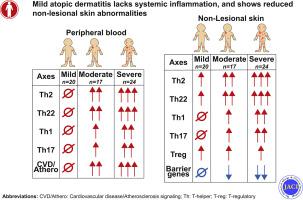Journal of Allergy and Clinical Immunology ( IF 11.4 ) Pub Date : 2020-10-01 , DOI: 10.1016/j.jaci.2020.08.041 Helen He 1 , Ester Del Duca 1 , Aisleen Diaz 1 , Hyun Je Kim 1 , Jesús Gay-Mimbrera 2 , Ning Zhang 1 , Jianni Wu 1 , Jessica Beaziz 1 , Yeriel Estrada 1 , James G Krueger 3 , Ana B Pavel 4 , Juan Ruano 2 , Emma Guttman-Yassky 1

|
Background
Molecular studies in atopic dermatitis (AD) are largely restricted to patients with moderate-to-severe disease.
Objective
Our aim was to evaluate skin and blood abnormalities in mild, moderate, and severe AD.
Methods
Skin and blood samples were obtained from 61 patients with AD (20 with mild or limited disease, 17 with moderate disease, and 24 with severe disease) and 20 healthy subjects. Immune and barrier markers were measured in lesional, nonlesional, and healthy skin by quantitative real-time PCR and immunohistochemistry, and in blood by using the OLINK proteomic assay.
Results
Cellular markers of epidermal hyperplasia and T-cell/dendritic cell infiltration were increased in AD tissues of all patients in all severity groups versus in those of controls, whereas downstream TH2 cell–, TH22 cell–, TH1 cell–, and TH17 cell–related mediators demonstrated incremental elevations with increasing disease severity, in both lesional and nonlesional skin. Whereas the levels of the TH2 (IL13, CCL17, and CCL26) and TH22 (IL-22) cytokines were significantly elevated in both AD lesional and nonlesional skin of all patients regardless of the severity of their disease, patients with mild or limited AD showed increases in their levels of TH1 cell (IFNG, CXCL9, and CXCL10) and TH17 cell (IL-17A, CCL20, and CXCL1) markers in lesional but not nonlesional skin. Regulatory T-cell–related mediators (IL-10 and FOXP3) were comparably upregulated in all groups, without displaying the severity-based gradient in other immune axes. Unsupervised clustering aligned samples along a severity spectrum, where nonlesional mild or limited AD skin clustered with the samples from healthy controls. Furthermore, whereas the blood profiles of patients with moderate and severe AD showed gradual increases in the levels of TH1 cell–, TH2 cell–, and TH17 cell–related and atherosclerosis and/or cardiovascular risk (CCL7, FGF21, and IGFBP1) proteins, the blood profiles of patients with mild or limited AD lacked significant differences from those of the controls.
Conclusion
Mild and limited AD show high levels of TH2/TH22 cell activation that is primarily localized to skin lesions and lacks the systemic inflammation of moderate and severe disease.
中文翻译:

轻度特应性皮炎无全身炎症,非损伤性皮肤异常减少
背景
特应性皮炎 (AD) 的分子研究主要限于患有中度至重度疾病的患者。
客观的
我们的目标是评估轻度、中度和重度 AD 的皮肤和血液异常。
方法
皮肤和血液样本来自 61 名 AD 患者(20 名轻度或局限性疾病,17 名中度疾病,24 名重度疾病)和 20 名健康受试者。通过定量实时 PCR 和免疫组织化学在病变、非病变和健康皮肤中测量免疫和屏障标志物,并使用 OLINK 蛋白质组学测定在血液中测量免疫和屏障标志物。
结果
与对照组相比,所有严重程度组的所有患者的 AD 组织中表皮增生和 T 细胞/树突细胞浸润的细胞标志物均增加,而下游 T H 2 细胞-、T H 22 细胞-、T H 1 细胞-和 T H 17 细胞相关介质在病变和非病变皮肤中随着疾病严重程度的增加而逐渐升高。尽管无论疾病的严重程度如何,所有患者的 AD 病变和非病变皮肤中T H 2(IL13、CCL17 和 CCL26)和 T H 22(IL-22)细胞因子的水平均显着升高,但轻度或有限的 AD 显示其 T H水平增加病变皮肤中的1 细胞(IFNG、CXCL9 和 CXCL10)和 T H 17 细胞(IL-17A、CCL20 和 CXCL1)标记物。调节性 T 细胞相关介质(IL-10 和 FOXP3)在所有组中均上调,但在其他免疫轴中未显示基于严重性的梯度。无监督聚类沿严重程度谱对齐样本,其中非病变轻度或有限 AD 皮肤与来自健康对照的样本聚类。此外,虽然中度和重度 AD 患者的血液特征显示 T H 1 细胞-、T H 2 细胞-和 T H17 细胞相关和动脉粥样硬化和/或心血管风险(CCL7、FGF21 和 IGFBP1)蛋白,轻度或有限 AD 患者的血液特征与对照组的血液特征没有显着差异。
结论
轻度和有限的 AD 显示出高水平的 T H 2/T H 22 细胞活化,主要定位于皮肤病变,缺乏中度和重度疾病的全身炎症。










































 京公网安备 11010802027423号
京公网安备 11010802027423号